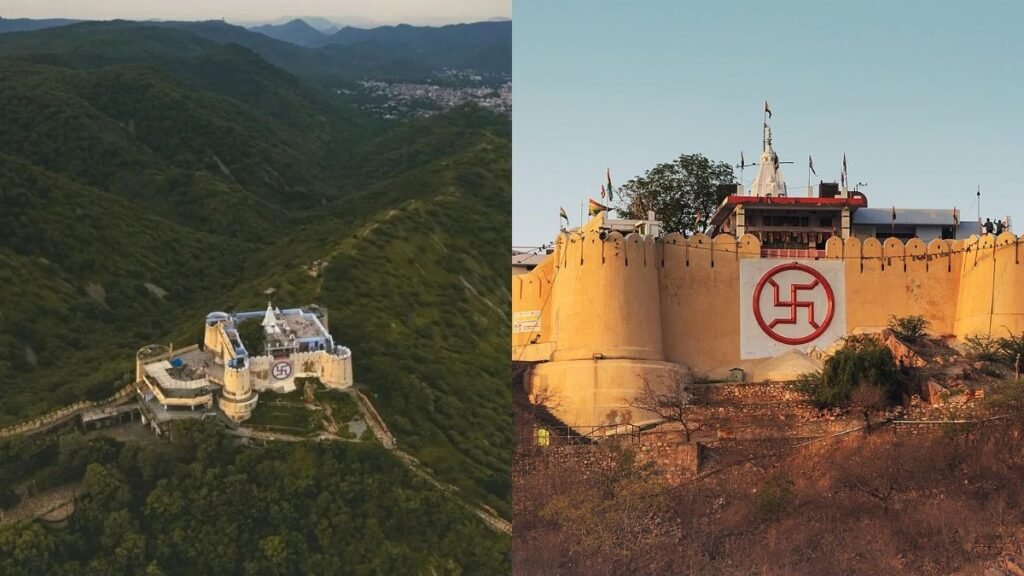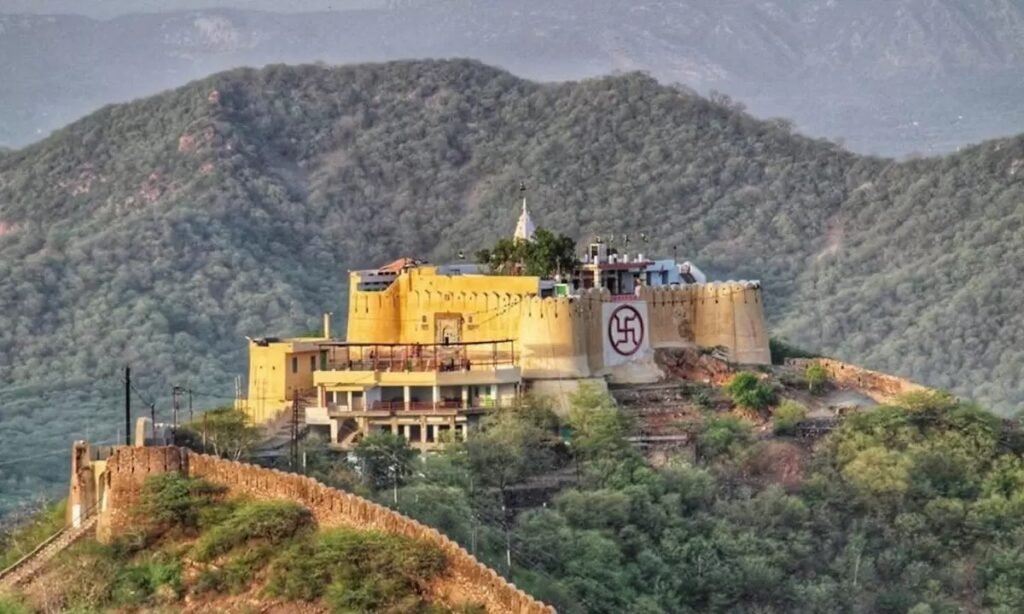Nestled atop the Aravalli Hills, Garh Ganesh Temple stands as an iconic spiritual and cultural monument in Jaipur, Rajasthan. Known for its rare depiction of Lord Ganesha without a trunk, the temple’s allure lies in its centuries-old legacy, captivating architecture, and vibrant local traditions. It continues to inspire devotees and tourists alike, making it a must-visit destination in the Pink City.
Location and Route
The Garh Ganesh Temple is situated on Kadamb Dungri Hill, near the Nahargarh and Jaigarh Forts, marking the northeast boundary of Jaipur. The temple overlooks the city, offering panoramic views of Jaipur. The easiest approach to the temple is by vehicle or public transport, followed by a climb of 365 steps, symbolising the days of the year. Visitors often park at ‘Gaitor ki Chhatriyan’ and ascend via the stairs, or take a scenic trekking route through lush green trails.
- By taxi: Only 7 minutes from the Jaipur city centre
- By subway and bus: Take the subway to Badi Chaupar, then a bus to Govind Nagar, Amer Road, followed by a short walk
- On foot: About a 1 hour 14 minute walk, approximately 6 km from Jaipur
Key Details:
History of Garh Ganesh Temple
The Garh Ganesh Temple dates back to the early 18th century, when it was built by Maharaja Sawai Jai Singh II, prior to the founding of Jaipur. The temple was constructed when the Maharaja performed the ritualistic ‘Ashwamedha Yagna’ and laid the city’s first foundation stone under the divine blessings of Lord Ganesha. Notably, the statue was placed so the Maharaja could see it from his palace using binoculars, symbolising the city’s protection by Ganesha.
This child-form idol, known as ‘Purushakriti’, is uniquely trunkless, a striking feature not found elsewhere in India. Its name, ‘Garh Ganesh’, literally translates to ‘Ganesha of the Fort’, emphasising its fortress-like structure on the hill.
Temple Architecture & Cultural Significance
Garh Ganesh Temple epitomises classic Rajasthani and Mughal architectural finesse, crafted from pink sandstone with intricate carvings and mythological motifs. The main idol, made in ‘Purushakriti’ form without a trunk, represents innocence and new beginnings. The temple’s facade, pillars, and interior exude regal craftsmanship, featuring numerous carvings that depict mythological stories.
The temple also houses idols of Riddhi-Siddhi (Ganesha’s wives) and their sons, Shubh-Labh. Ceremonies are held throughout the year, such as ‘Anna-koot’ after Diwali and ‘Paush bade’ during the Paush Month, festivals that bring crowds together for collective prayers and feasts.
Culturally, Garh Ganesh acts as the spiritual starting point for Jaipur. Since Maharaja Sawai Jai Singh’s time, all auspicious city events begin from here, cementing its role as protector and benefactor of Jaipur’s growth and prosperity.
Pilgrimage and Treks
Garh Ganesh Temple isn’t just a place of worship; it’s a hub for trekkers and spiritual-seekers. The 365-step ascent is both physically and spiritually rewarding, symbolising a year-round journey towards enlightenment. The trek to Garh Ganesh is relatively easy and offers stunning vistas of Jaipur city and the nearby Nahargarh hills.
Many choose to extend their trek to Charan Mandir or even Hathni Kund, ideal for those seeking fresh air, nature, and a deeper connection to the landscape. These treks range from 2 to 8 km, with varying levels of difficulty but consistently offer breathtaking views.
Festivals and Events
Garh Ganesh Temple is central to several key celebrations in Jaipur. The largest is Ganesh Chaturthi, a grand five-day fair that attracts thousands of worshippers from India and beyond. Devotees believe wishes made here, especially during seven consecutive Wednesdays, are fulfilled, a tradition that has seen a social media-driven resurgence recently.
Other major festivals include Diwali’s Anna-koot and Paush Bade, where the temple hosts communal prayer sessions, charity meals, and cultural performances. These traditions transform the temple into a vibrant heart of spiritual and social activity.
Temple Revenue and Operations
Garh Ganesh Temple does not charge entry fees; instead, it operates on voluntary donations from devotees and visitors. Festival donations, charitable contributions, and offerings provide primary revenue, sustaining the temple’s upkeep, rituals, and community services.
Its surge in visitors during festival periods, especially Ganesh Chaturthi, generates significant revenue from religious tourism for local vendors, transport operators, and nearby accommodations, ultimately benefiting Jaipur’s broader economy. The temple is managed by the Audhchya family, who oversee rituals, ceremonies, and administrative functioning.

Garh Ganesh Temple as a Tourist Spot
For travellers, the Garh Ganesh Temple is not just sacred but scenic. The top of the Aravalli hills offers unrivalled views of Jaipur, especially during sunrise and sunset. Its proximity to key Jaipur attractions, such as Nahargarh Fort, Amber Fort, and City Palace, makes it a popular circuit among tourists. Being open from 7:30 am to 12:00 pm and 4:00 pm to 8:00 pm, travellers can plan their visits conveniently.
Photography is typically prohibited inside the temple to maintain sanctity, but outside, visitors can capture breathtaking cityscapes.
Culture & Local Traditions
Local lore holds that letters of wishes, delivered by mice (Ganesha’s vehicle in mythology), reach Lord Ganesha directly, amplifying the temple’s mystical significance. The site is often bustling with prayer chants, incense, and the sounds of bells, creating an immersive atmosphere that fosters devotion.
Regular visitors attest to experiencing miracles after completing the seven-week pilgrimage, a belief that draws repeated visits from both locals and long-distance devotees.
Recent News Headline (2025)
“Garh Ganesh Temple 2025: Surge in Devotees Fulfilling Wishes After Viral Seven Wednesday Ritual”
Recent news highlights an unprecedented surge in devotee visits driven by social media awareness about the ‘seven Wednesday’ tradition. Temple authorities and local administration have responded by enhancing facilities and organising larger community gatherings, making Garh Ganesh more accessible and welcoming than ever before.
FAQs About Garh Ganesh Temple
What makes the Garh Ganesh Temple unique?
Garh Ganesh is the only temple in India with a child-form, trunkless idol of Lord Ganesha, symbolising purity and new beginnings.
Who built the temple and why?
Maharaja Sawai Jai Singh II built the temple in the 18th century, before founding Jaipur, to protect the city and invoke Lord Ganesha’s blessings.
How can visitors reach the Garh Ganesh Temple?
It is accessible via vehicle, public transport, and trekking. There is a parking area at the base, and 365 steps lead to the top.
What are the temple timings and entry fees?
The temple is open from 7:30 a.m. to 12:00 p.m. and from 4:00 p.m. to 8:00 p.m. There is no entry fee, but donations are welcome.
When are the major festivals at the temple?
Ganesh Chaturthi is the biggest festival, alongside Anna-koot after Diwali and Paush Bade during Paush month.
What are the routes and trek details?
Trekking is easy, starting from the Gaitor ki Chhatriyan parking. Treks range from 2-8 km, offering scenic views and a pilgrimage experience.
Is the Garh Ganesh Temple a popular tourist spot?
Yes, it is a popular destination for devotees and tourists seeking heritage, spirituality, and panoramic city views.
Who manages the temple?
The Audhchya family oversees the overall management of the temple, including rituals and festivals.
Conclusion
Garh Ganesh Temple is a living testament to Jaipur’s legacy, devotion, and royal heritage. With its singular trunkless idol, immersive traditions, and breathtaking location, the temple invites both worship and wonder, whether one seeks religious solace, architectural beauty, or the energy of communal celebration. Its recent revitalisation and global attention ensure that Garh Ganesh stands tall as an essential landmark of faith and tourism in Rajasthan.
